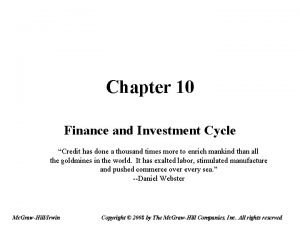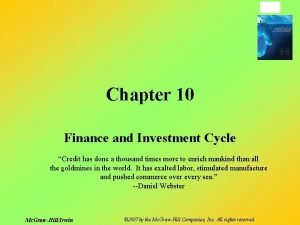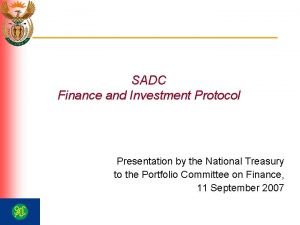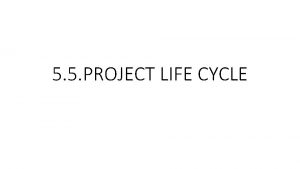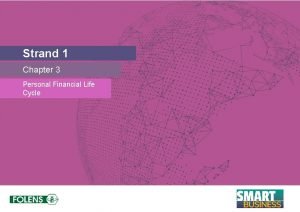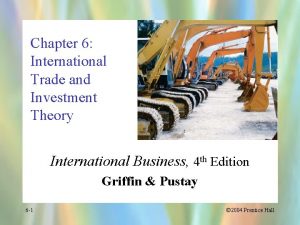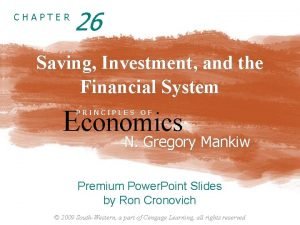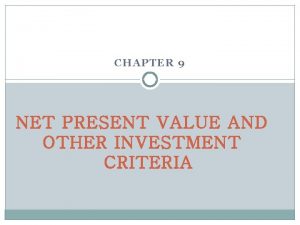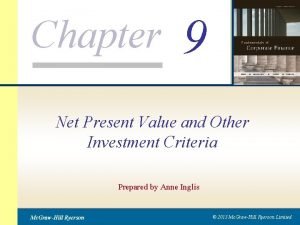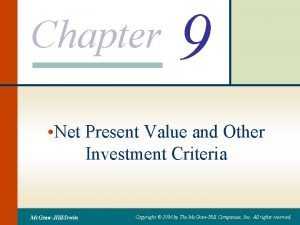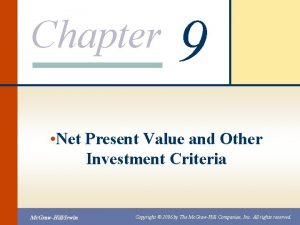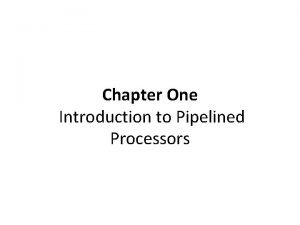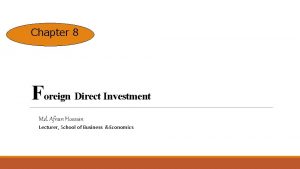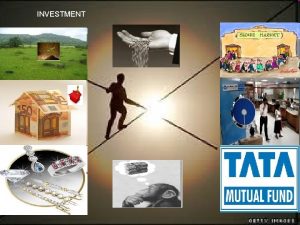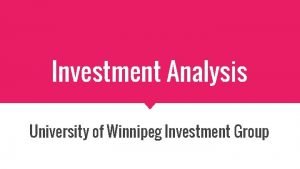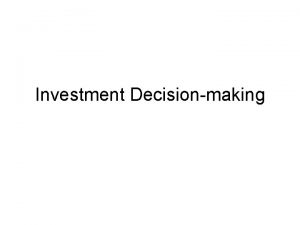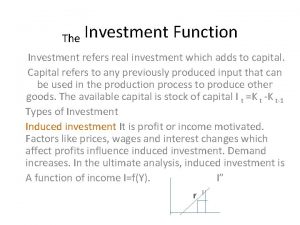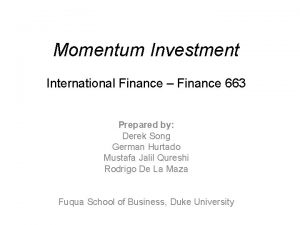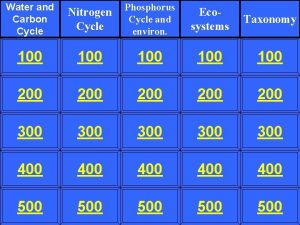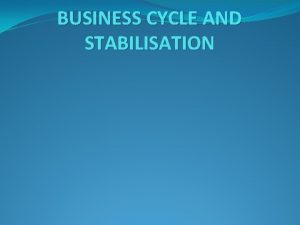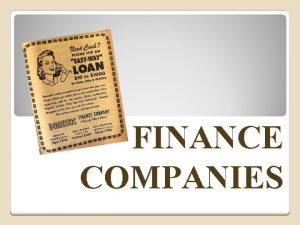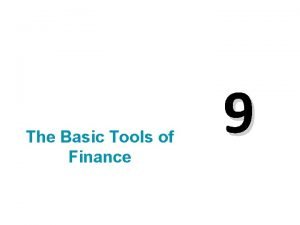10 1 Chapter 10 Finance and Investment Cycle






















- Slides: 22

10 -1 Chapter 10 Finance and Investment Cycle “Credit has done a thousand times more to enrich mankind than all the goldmines in the world. It has exalted labor, stimulated manufacture and pushed commerce over every sea. ” --Daniel Webster Mc. Graw-Hill/Irwin © 2007 by the Mc. Graw-Hill Companies, Inc. All rights reserved.

10 -2 Presentation Outline I. Overview of Finance and Investing Cycle II. Audit of Liabilities and Stockholders’ Equity III. Audit of Investments Mc. Graw-Hill/Irwin © 2007 by the Mc. Graw-Hill Companies, Inc. All rights reserved.

10 -3 I. Overview of Finance and Investing Cycle A. Investing and Financing Cycle Activities B. Inherent Risks C. Investment and Finance Activities D. Control Considerations E. Finance and Investment Cycle: Control Procedures F. Control Over Accounting Estimates Mc. Graw-Hill/Irwin © 2007 by the Mc. Graw-Hill Companies, Inc. All rights reserved.

10 -4 A. Investing and Financing Cycle Activities • Concerned with transactions related to the use of the organization's funds (investing) and sources of those funds (financing) other than operations. • Accounts affected by investing and financial cycle transactions include investments in securities; property, plant and equipment; notes and bonds payable; and, stockholders' equity accounts. Mc. Graw-Hill/Irwin © 2007 by the Mc. Graw-Hill Companies, Inc. All rights reserved.

B. Inherent Risks • Lease Accounting – circumventing capital lease rules to remove debt from balance sheet. • Loan covenants – intentional misstatement to avoid having banks call loans. • Related party transactions – more risk because they are not at arms-length. • Complex transactions – transactions are often structured to get around GAAP. Makes them difficult and hard to audit. • Impairments – taking a big bath in bad years for investments to create reserves to reduce expenses in the future. Mc. Graw-Hill/Irwin © 2007 by the Mc. Graw-Hill Companies, Inc. All rights reserved. 10 -5

10 -6 Mc. Graw-Hill/Irwin © 2007 by the Mc. Graw-Hill Companies, Inc. All rights reserved.

C. Investment and Finance Activities 10 -7 • Financial Planning – cash flow planning and capital budgeting serve as controls. • Raise capital – signature approval of high-ranking officers and consent of board of directors. Registrars and transfer agents (p. 364) • Operate business (all other cycles) – all cycles interact with finance and investment cycle. • Mergers and acquisitions – involve sources and uses of funds. • Invest excess funds – earning a short-term return on excess cash. Mc. Graw-Hill/Irwin © 2007 by the Mc. Graw-Hill Companies, Inc. All rights reserved.

10 -8 D. Control Considerations • Transactions authorized by BOARD OF DIRECTORS • Documentation: – Investments in securities: BROKER'S ADVICE – Property, plant and equipment: VENDOR'S INVOICE (for purchased PPE) or INTERNAL COST RECORDS (for manufactured PPE) – Bonds and notes payable: Documentation from DEBTHOLDERS – Stockholders' Equity: Documentation from REGISTRAR • CASH RECEIPTS/DISBURSEMENTS JOURNALS Mc. Graw-Hill/Irwin © 2007 by the Mc. Graw-Hill Companies, Inc. All rights reserved.

E. Finance and Investment Cycle: Control Procedures 10 -9 • Physical Controls – Securities numbered and in the client's name – Securities held by an independent custodian or in a secure location – Access to safe-deposit box requires the presence of more than one employee – Physical items periodically compared to detail records – Cash receipts from Investing and Financing cycle transactions deposited intact and daily • Segregation of Duties – Transactions AUTHORIZED by the Board of Directors – General Accounting RECORDS transactions – A separate function or external custodian has CUSTODY • Performance Reviews – Compare current investing and cycle transaction data against prioryear data or expected data – Compare revenue and expenses against organization standards or expectations. Mc. Graw-Hill/Irwin © 2007 by the Mc. Graw-Hill Companies, Inc. All rights reserved.

F. Control Over Accounting Estimates 10 -10 A sample of accounting estimates are provided on the top of p. 368. Specific aspects of estimate development an auditor considers include: • Management emphasis on proper estimation • Accumulation of sufficient relevant data from reliable sources • Qualified personnel prepare estimates • Review and approval at appropriate levels of authority • Comparison of prior estimates to results to evaluate reliability of estimate approach. • Determine if estimates are consistent with current company plans and operations. Mc. Graw-Hill/Irwin © 2007 by the Mc. Graw-Hill Companies, Inc. All rights reserved.

10 -11 II. Audit of Liabilities and Stockholders’ Equity A. Substantive Testing for Interest-Bearing Liabilities B. Audit Documentation – Exhibit 10. 4 C. General Audit Concerns for Stockholders’ Equity D. Auditing Paid-in Capital E. Auditing Retained Earnings Mc. Graw-Hill/Irwin © 2007 by the Mc. Graw-Hill Companies, Inc. All rights reserved.

10 -12 A. Substantive Testing for Interest. Bearing Liabilities • Agree to BEGINNING BALANCE and CONFIRM with holders or makers. • LOAN PROCEEDS – VOUCH to cash receipts – Recalculate Discount/Premium – Examine note for interest, payment terms, collateral, debt covenants, etc. • LOAN PAYOFF – Recalculate Interest Expense – Recalculate Gain/Loss on Retirement – Verify cash disbursements Mc. Graw-Hill/Irwin © 2007 by the Mc. Graw-Hill Companies, Inc. All rights reserved.

10 -13 A. Substantive Testing for Interest. Bearing Liabilities (Continued) • INTEREST PAYMENTS – Recalculate Interest Expense • Search for UNRECORDED liabilities – – Inquiry of management Bank confirmations Unusual amounts of interest expense Large receipts of cash during the year • Ensure DEBT COVENANTS are met. – Inspect loan agreements. – Consider GOING CONCERN implications if not met. – Ensure proper presentation and disclosure. Mc. Graw-Hill/Irwin © 2007 by the Mc. Graw-Hill Companies, Inc. All rights reserved.

10 -14 B. Audit Documentation – Exhibit 10. 4 p. 371 Mc. Graw-Hill/Irwin © 2007 by the Mc. Graw-Hill Companies, Inc. All rights reserved.

10 -15 C. General Audit Concerns for Stockholders’ Equity • Overview of audit approach – EXTERNAL PARTIES involved in record keeping can confirm stockholders’ equity. Otherwise, items can be vouched to the certificate book stubs. – Transactions must be authorized by the BOARD OF DIRECTORS – Transactions must be consistent with the client's ARTICLES OF INCORPORATION Mc. Graw-Hill/Irwin © 2007 by the Mc. Graw-Hill Companies, Inc. All rights reserved.

10 -16 D. Auditing Paid-in Capital – Agree balances to prior year documentation – Examine issuances and repurchases of capital stock • Verify distribution of proceeds between CAPITAL STOCK and ADDITIONAL PAID-IN CAPITAL • Examine CASH RECEIPTS and CASH DISBURSEMENTS records • Determine that all transactions are RECORDED (TRACE from BOD minutes) • Verify that all transactions are PROPERLY AUTHORIZED Mc. Graw-Hill/Irwin © 2007 by the Mc. Graw-Hill Companies, Inc. All rights reserved.

10 -17 E. Auditing Retained Earnings – Agree beginning balance with prior year documentation – Verify the appropriateness of prior-period adjustment treatment – Trace net income/loss to INCOME STATEMENT – Ensure that DIVIDENDS are properly authorized by BOARD OF DIRECTORS Mc. Graw-Hill/Irwin © 2007 by the Mc. Graw-Hill Companies, Inc. All rights reserved.

10 -18 III. Audit of Investments A. Substantive Audit Procedures for Investments B. Trouble Spots in the Audit of Investments Mc. Graw-Hill/Irwin © 2007 by the Mc. Graw-Hill Companies, Inc. All rights reserved.

10 -19 A. Substantive Audit Procedures for Investments • Agree balances to Prior Year Documentation • Purchases of investments – VOUCH to BROKER'S ADVICE (Statement) – Examine BOARD MINUTES for authorization • Sales of investments – VOUCH to BROKER'S ADVICE, CASH RECEIPTS RECORDS, and BOARD MINUTES – Recalculate gain or loss on sale – Read minutes for sales of Investments and trace to recording Mc. Graw-Hill/Irwin © 2007 by the Mc. Graw-Hill Companies, Inc. All rights reserved.

10 -20 A. Substantive Audit Procedures for Investments (Continued) • Determine MARKET VALUE (SFAS 115) – Obtain 12/31 market price from Wall Street Journal or other sources – Evaluate for possible PERMANENT DECLINES • PHYSICALLY INSPECT or CONFIRM securities Verify Certificate Numbers to ensure that there were no unrecorded sales and subsequent repurchases – Made in company name – Can inspect at interim, if safe-deposit box • Verify DIVIDEND REVENUE – Examine CASH RECEIPTS records – Compare to external sources (Moody's, Standard & Poor's) • Evaluate presentation in BALANCE SHEET (short-term vs. long-term asset) Mc. Graw-Hill/Irwin © 2007 by the Mc. Graw-Hill Companies, Inc. All rights reserved.

B. Trouble Spots in the Audit of Investments 10 -21 • Valuation of investments at cost, market, or value impairment that is other than temporary. • Propriety, effectiveness, and risk disclosure of derivative securities used as a hedges • Determination of the fair value of derivatives and securities, including valuation models and the reasonableness of key assumptions. • Determination of significant influence relationship for equity method investments. Mc. Graw-Hill/Irwin © 2007 by the Mc. Graw-Hill Companies, Inc. All rights reserved.

10 -22 Summary • Accounts involving Investments, Property-Plant and Equipment, Debt, and Equity • Inherent risk for leases, loan covenants, related parties, complex transactions, and big baths • Estimate process and evaluation • Audit of liabilities and stockholders’ equity • Value of investments and amount of investment income Mc. Graw-Hill/Irwin © 2007 by the Mc. Graw-Hill Companies, Inc. All rights reserved.
 Finance and investment cycle
Finance and investment cycle Finance and investment cycle
Finance and investment cycle Fixed investment and inventory investment
Fixed investment and inventory investment Sadc protocol on finance and investment
Sadc protocol on finance and investment Investment banking activities
Investment banking activities Chapter 5 two-cycle and four-cycle engines answers
Chapter 5 two-cycle and four-cycle engines answers Investment phase of project development cycle
Investment phase of project development cycle Personal financial planning life cycle
Personal financial planning life cycle Chapter 6 theories of international trade and investment
Chapter 6 theories of international trade and investment Mankiw chapter 26 solutions
Mankiw chapter 26 solutions Advantages and disadvantages of payback method
Advantages and disadvantages of payback method Chapter 9 net present value and other investment criteria
Chapter 9 net present value and other investment criteria Chapter 9 net present value and other investment criteria
Chapter 9 net present value and other investment criteria Chapter 9 net present value and other investment criteria
Chapter 9 net present value and other investment criteria Significance of biogeochemical cycle
Significance of biogeochemical cycle Difference between phosphorus cycle and carbon cycle
Difference between phosphorus cycle and carbon cycle Difference between open cycle and closed cycle gas turbine
Difference between open cycle and closed cycle gas turbine Reservation table in computer architecture
Reservation table in computer architecture Mhd generator ppt
Mhd generator ppt The investment environment chapter 1 ppt
The investment environment chapter 1 ppt Intermediate accounting kieso chapter 17 investment
Intermediate accounting kieso chapter 17 investment Cca tax shield formula
Cca tax shield formula Afnan hossain
Afnan hossain
